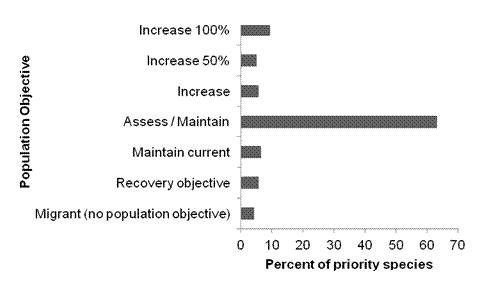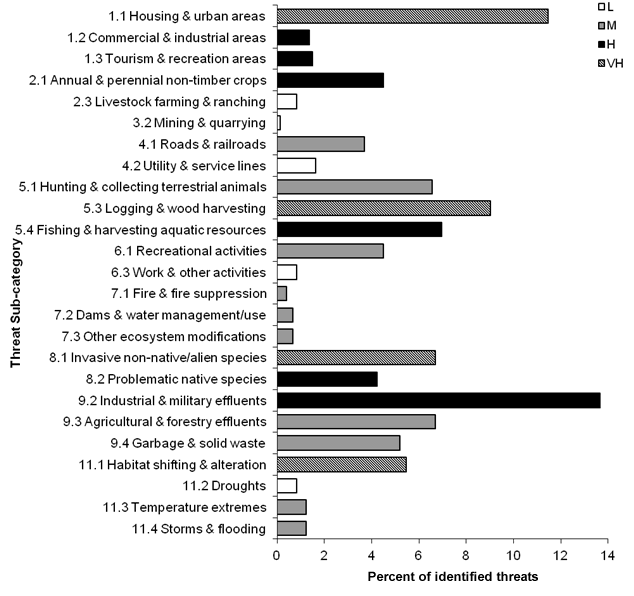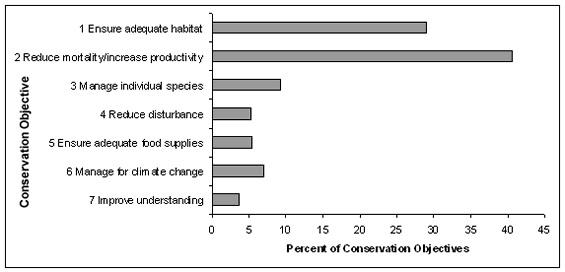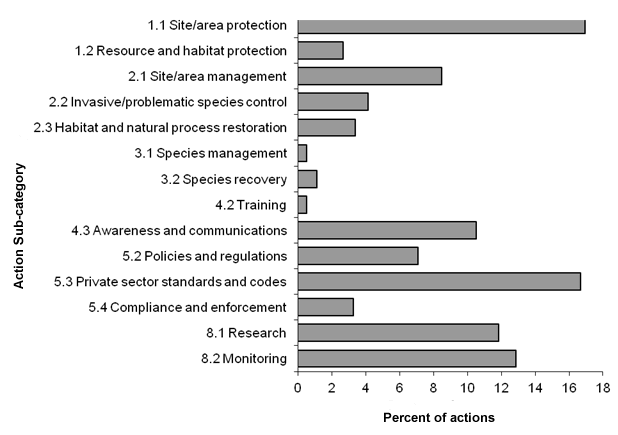Bird conservation strategy for region 5: Northern Pacific rainforest, chapter 6
Section 1: Summary of results -- All Birds, All Habitats
Element 1: Priority species assessment
These Bird Conservation Strategies identify “priority species” from all regularly occurring bird species in each BCR subregion (see Appendix 1). Species that are vulnerable due to population size, distribution, population trend, abundance and threats are included because of their “conservation concern.” Some widely distributed and abundant “stewardship” species are also included. Stewardship species are included because they typify the national or regional avifauna and/or because they have a large proportion of their range and/or continental population in the subregion; many of these species have some conservation concern, while others may not require specific conservation effort at this time. Species of management concern are also included as priority species when they are at (or above) their desired population objectives but require ongoing management because of their socio-economic importance as game species or because of their impacts on other species or habitats (see Appendix 2).
The purpose of the prioritization exercise is to focus implementation efforts on the issues of greatest significance for Canadian avifauna. Table 1 provides a full list of all priority species and their reason for inclusion. Tables 2 and 3 summarize the number of priority species in BCR 5 Pacific and Yukon by bird group and by the reason for priority status.
In BCR 5, the priority species list is dominated by landbirds (57 of 139 priority species) and waterbirds (38 species). Over half of the waterbirds (56%) and waterfowl (62%) occurring in BCR 5 were identified as priority species, as compared to only 39% of the landbirds. Forty-six percent (46%) of the priority species are considered at risk, either federally or provincially.
In BCR 5, Canada Geese were identified as a priority species. Historically, Canada Goose populations in southern British Columbia were characterized by very low densities and a scattered distribution, but, through transplant programs and natural dispersal, these Canada Geese have expanded their distribution and abundance in BCR 5 significantly over the last three decades (e.g., southeast Vancouver Island, Lower Mainland, Fraser Valley). In this strategy, population objectives, identified threats and recommended actions related to Canada Geese refer solely to migratory populations, and do not refer to resident populations that both breed and winter in urban areas. These resident geese are responsible for a high incidence of conflicts with humans, and urban authorities (such as municipal governments) may elect to set population objectives for resident Canada Geese and manage toward that goal through habitat modification and control measures.
Table 1. Priority species in BCR 5 Pacific and Yukon, population objective, and the reason for priority status. Accessible Version of Table 1.
| Bird group | Total species | Total priority species | Percent listed as priority | Percent of priority list |
|---|---|---|---|---|
| Landbird | 147 | 57 | 39% | 41% |
| Shorebird | 36 | 18 | 50% | 13% |
| Waterbird | 68 | 38 | 56% | 27% |
| Waterfowl | 42 | 26 | 62% | 19% |
| Total | 293 | 139 | 100% |
| Reason for priority listinga | Landbirds | Shorebirds | Waterbirds | Waterfowl |
|---|---|---|---|---|
| COSEWICb | 16 | 2 | 7 | 0 |
| Federal SARA listedc | 14 | 2 | 6 | 0 |
| Provincially listedd | 23e | 6 | 24f | 6 |
| NAWMPg | - | - | - | 26 |
| National/continental concern | 8 | 11 | 13 | - |
| Regional concern | 19 | - | - | - |
| National/continental stewardship | 8 | - | - | - |
| Regional stewardship | 29 | 8 | 25 | - |
a A single species can be on the priority list for more than one reason. Note that not all reasons for inclusion apply to every bird group (indicated by “-”).
b COSEWIC indicates species assessed by the Committee on the Status of Endangered Wildlife in Canada as Endangered, Threatened, or Special Concern.
c Species listed on Schedule 1 of the Species at Risk Act as Endangered, Threatened, or Special Concern.
d Provincially Listed indicates species listed by Red-listed or Blue-listed by British Columbia’s Conservation Data Centre.
e Three additional species have provincially-listed subspecies: Hairy Woodpecker (picoideus), Steller’s Jay (carlottae), and Northern Pygmy Owl (swarthi).
f One additional species, the Pelagic Cormorant, has a provincially-listed subspecies (pelagicus).
g North American Waterfowl Management Plan (NAWMP) indicates species ranked in the North American Waterfowl Management Plan (Plan Committee 2004) as having Moderately High, High or Highest breeding or non-breeding conservation and/or monitoring need in the BCR.
Element 2: Habitats important to priority species
Identifying the broad habitat requirements for each priority species within the BCR allowed species to be grouped by shared habitat-based conservation issues and actions (see Appendix 2 for details on how species were assigned to standard habitat categories). If many priority species associated with the same habitat face similar conservation issues, then conservation action in that habitat may support populations of several priority species. BCR strategies use a modified version of the standard land cover classes developed by the United Nations (Food and Agriculture Organization 2000) to categorize habitats and species were often assigned to more than one habitat class.
In BCR 5, a maximum of two broad-scale habitat associations were identified for each priority species. In BCR 5, coastal habitats and marine waters are used by the greatest number of priority species (68 and 42 species, respectively; Fig. 3). Coniferous forests (31 species) and herbaceous habitats (grassland and agricultural areas; 29 species) are also widely used.
Figure 3. Percent of priority species that are associated with each habitat type in BCR 5 Pacific and Yukon.
Note: The total exceeds 100% because each species may be assigned to more than one habitat.

Element 3: Population objectives
Population objectives allow us to measure and evaluate conservation success. The objectives in this strategy are assigned to categories and are based on a quantitative or qualitative assessment of species’ population trends. If the population trend of a species is unknown, the objective is set as “assess and maintain,” and a monitoring objective is given (see Element 3: Population Objectives for Priority Species). For any species listed under the Species at Risk Act (SARA) or under provincial/territorial endangered species legislation, Bird Conservation Strategies defer to population objectives in available Recovery Strategies and Management Plans. The ultimate measure of conservation success will be the extent to which population objectives have been reached over the next 40 years. Population objectives do not currently factor in feasibility of achievement, but are held as a standard against which to measure progress.
Over 63% of priority species, with representatives from all bird groups, were assigned an objective to “assess” population status while “maintaining” current levels in the interim (Fig. 4). For 6% of species, population levels were deemed to be at or near the objective. Five percent (5%) and 9% of species were assigned objectives to increase the population by 50% and to double the population, respectively. For a small proportion of species (6%), all SARA-listed, we have deferred to the population objectives developed in Recovery Strategies.
Figure 4. Percent of priority species that are associated with each population objective category in BCR 5 Pacific and Yukon.

Element 4: Threat assessment for priority species
The threats assessment process (see Element 4: Threat Assessment for Priority Species) identifies threats believed to have a population-level effect on individual priority species. These threats are assigned a relative magnitude (Low, Medium, High, Very High), based on their scope (the proportion of the species’ range within the subregion that is impacted) and severity (the relative impact on the priority species’ population). This allows us to target conservation actions towards threats with the greatest effects on suites of species or in broad habitat classes. Some well known conservation issues (such as predation by domestic cats or climate change) may not be identified in the literature as significant threats to populations of an individual priority species and therefore may not be captured in the threat assessment. However, they merit attention in conservation strategies because of the large numbers of individual birds affected in many regions of Canada. We have incorporated them in a separate section on Widespread Issues, but, unlike other threats, they are not ranked.
Residential and commercial development (1.1 Housing and urban areas) was recognized to be a very high threat (Fig. 5) across most terrestrial habitat types for many priority species (including waders like the Great Blue Heron, many shorebirds, and several raptor species, including owls). This is probably most true in southern parts of the BCR, such as the Lower Mainland and southeastern Vancouver Island. Logging and wood harvesting was identified as a very high threat in all forested habitats for many priority species (e.g., Northern Saw-whet Owl, Marbled Murrelet, Chesnut-backed Chickadee, Harlequin Duck). Invasive non-native species also emerged as a very high threat, particularly in coastal habitat. Many of these are colonial-nesting seabirds subject to predation by introduced mammalian predators (rats, racoons, mink) on offshore islands. Climate change (11.1 Habitat shifting and alteration) also was identified as a very high threat, and again the list of affected species is dominated by seabirds, like Pink-footed Shearwater and Cassin’s Auklet, as warming sea surface temperatures are thought to be linked to lower ocean productivity. Climate change may manifest in the form of sea level rise which may eliminate or severely reduce the extent of certain coastal habitats (e.g., mudflats) that are key migratory stopover foraging sites for shorebird species such as Western Sandpiper, Dunlin, and Red Knot. Finally, oil pollution (9.2 Industrial and military effluents) emerged as a high-level threat for a great number of seabirds and waterbirds (e.g., Black-footed Albatross, Common Murre, Pelagic Cormorant) that rely on coastal and offshore marine waters throughout the BCR.
Figure 5. Percent of identified threats to priority species within BCR 5 Pacific and Yukon by threat sub-category.
Each bar represents the percent of the total number of threats identified in each threat sub-category in BCR 5 (for example, if 100 threats were identified in total for all priority species in BCR 5, and 10 of those threats were in the category 1.1 Housing and urban areas, the bar on the graph would represent this as 10%). Shading in the bars (VH = very high, H = high, M = medium and L = low) represents the rolled up magnitude of all threats in each threat sub-category in the BCR. (See Element 4: Threat Assessment for Priority Species for details on how magnitude was assessed).

Table 4. Relative magnitude of identified threats to priority species within BCR 5 Pacific and Yukon by threat category and broad habitat class.
Overall ranks were generated through a roll-up procedure described in Kennedy et al. (2012). L represents Low Magnitude threats; M = Medium; H = High; VH = Very High. Blank cells indicate that no priority species had threats identified in the threat category/habitat combination. Accessible Version of Table 4.
Threats to priority species while they are outside Canada during the non-breeding season were also assessed and are presented in the section Threats Outside Canada.
Element 5: Conservation objectives
Conservation objectives were designed to address threats and information gaps that were identified for priority species. They describe the environmental conditions and research and monitoring that are thought to be necessary for progress towards population objectives and to understand underlying conservation issues for priority bird species. As conservation objectives are reached they will collectively contribute to achieving population objectives. Whenever possible, conservation objectives were developed to benefit multiple species, and/or respond to more than one threat (see Element 5: Conservation Objectives).
The majority of conservation objectives for BCR 5 relate to maintaining or enhancing habitat quality and quantity, and reducing mortality or increasing productivity (Fig. 6). Ensuring adequate habitat includes maintenance of the full range of naturally-occurring habitat types, maintaining the quality of existing habitats, and retaining important features on the landscape (e.g., standing dead snags for cavity nesting birds). Reducing mortality includes addressing a wide suite of sources of accidental mortality, including bycatch in commerical fisheries, ingestion of plastic or lead shot, exposure to oil, collisions with man-made structures, destruction of nests, and pesticide poisoning.
Figure 6. Percent of all conservation objectives assigned to each conservation objective category in BCR 5 Pacific and Yukon.

Element 6: Recommended actions
Recommended actions indicate on-the-ground activities that will help to achieve the conservation objectives. Actions are strategic rather than highly detailed and prescriptive (see Element 6: Recommended Actions). Whenever possible, recommended actions benefit multiple species, and/or respond to more than one threat. Recommended actions defer to or support those provided in recovery documents for species at risk at the federal, provincial or territorial level, but will usually be more general than those developed for individual species.
Given the importance in BCR 5 of conservation objectives relating to the maintenance and enhancement of habitat, it is not surprising that securing and protecting habitat emerges as a key theme (Fig. 7; 1.1 Site/area protection). Actions relating to the development of beneficial management practices or other voluntary private sector codes of practice (5.3 Private sector standards and codes) are similarly common, in part because site management and protection actions often have aspects that relate to the development of voluntary best practices. Another large set of recommended actions relate to policy and practices (5.2 Policies and regulations) surrounding fisheries bycatch of seabirds. A significant proportion of actions fall into both the research (8.1) and monitoring (8.2) categories, indicating that knowledge gaps exist for specific species (relating either to a specific threat or current population status) where more information is required before conservation actions can be effectively formulated.
Figure 7. Percent of recommended actions assigned to each sub-category in BCR 5 Pacific and Yukon.
5.3 Private sector standards and codes includes adoption of voluntary codes of practice, including sector-specific Beneficial management practices for bird conservation. 8.1 Research and 8.2 Monitoring refer to specific species where information is required before conservation actions can be formulated. For a discussion of broad-scale research and monitoring requirements, see Research and Population Monitoring Needs in Section 3.
